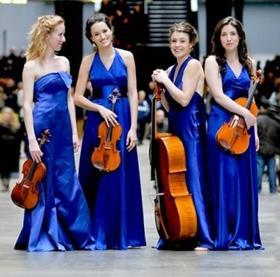Violinist, composer and chamber music festival founder Natalie Klouda writes the advice she would like to have been given when she was starting out

I was extremely fortunate to have the opportunity to study chamber music performance intensively throughout my twenties. I spent a lot of that time with a furrowed brow throughout quartet rehearsals (aptly named, my ‘focused face’) immersed in trying to solve endless musical and practical questions.
Spending several years working on string quartet repertoire and techniques enabled me and my colleagues to collect pearls of wisdom from an incredibly rich musical tradition, and I feel thoroughly grateful to all the thoughtful, passionate and inspiring musicians I’ve had the opportunity to work and study with. The collaboration element of searching for answers is very special and I would like to dearly thank my Finzi Quartet colleagues for the journey we shared in our early careers. I draw and build on those experiences every day in my professional life.
The following is a small compilation of some chamber music ideas which I would have liked to have been given all in one go at the start of my studies:
1. Rehearsing effectively is an art in itself. The aim is to eventually get to the point of not needing to, verbally, say very much. Having enough awareness to receive, understand and react to musical ideas whilst playing, as well as positively input ideas into the mix. It is an ultimate aim which finally lends itself to the musical ‘holy grail’ of communal comprehensible spontaneity, on stage. Exhilarating for both performers and audience alike!

2. If a player has an idea they would like to try – whether its a rehearsal technique or an articulation – try it wholeheartedly straight away … even if all your instincts are immediately against it. This approach saves huge amounts of time and frustration and, how wonderful when a seemingly ridiculous idea works! It is also a wonderful sign of respect between colleagues, and in trying the idea the success or otherwise of that idea is usually immediately apparent.
3. You would be surprised how many players starting college and beyond haven’t ‘got to know’ the inch before the bow hairs touch the string. As a result, they have very little control over the depth of desired hair contact. This is quite a crucial component for any string player and, whilst playing ‘together’ certainly isn’t everything, it is an important skill to have. When required, this can make the composer’s message far more effective.
4. All players need to know where they are going to/coming from in any given phrase, especially in, say, Haydn’s quartets. If not, the music dies, essentially flat-lining. This can be effective in some circumstances, but it is the exception rather than the rule.
5. Develop a musical ‘colour palette’ individually and as a group. Everyone has their own colours that they bring to the table and a wonderful transaction of colour options can be drawn from there. If a colleague finds a particularly special colour, search for it from your instrument. Become an expert colour thief!
Once a group has a broad mutual colour palette, then the fun can begin with colour/balance experimentation. For example if four players play a chord all using the same contact point and speed of bow, it can sound incredibly powerful but in another context it can just sound confusing to the listener, a little like a painting where the picture is all in the foreground with no depth of field. By simply mixing up contact point/speed of bow, it can suddenly bring a blended sound which is ‘comprehensible’. It can also sometimes solve ‘intonation conundrums’ where everyone is convinced they are ‘in tune’ yet the overall effect is still not clicking. Nuancing the dynamic or colour of the parts can blend the chord resolving the perceived clash without actually changing the pitching under the finger.
Experimenting with tone production, balance and colour enables the ensemble to become ‘more than the sum of its parts’. A chamber ensemble can become a new musical organism in its own right, made up of, in the case of a string quartet, 16 strings 4 bows and 4 souls, all coming together for a common performance and musical vision with an infinite range of colours, interest and creativity. Magic!
6. Awareness of roles is very important both for communication and musical expression. Interaction combinations follow on from awareness of balance and includes knowledge of ‘roles’. This interplay is endlessly fascinating for audiences and a huge part of the draw and appeal of attending chamber music performances. The conversational aspect and intimacy of a small number of people performing together can be hugely engaging especially when enjoyed by the performers.
7. But these roles can pigeonhole a player’s skillset. In a string quartet, ideally you want four fantastic players but it can be difficult to maintain one’s overall performance especially for ‘inner players’ who don’t swap. Look after each other’s artistry for the benefit of the whole group. Every player needs time and opportunities to nourish themselves and to hear and nurture their own voice in order to be able to give their best to a group situation. Be wise with time and compassionate in approach.
8. Try to approach a musical work imagining that you have only ever heard the music which preceded it. Be aware of what was wondrous and new when an audience heard the premiere of a work, say, 200 years ago. We are largely desensitised to what might have been, for instance, unusual or painful harmonies. If you point them out to today’s audience then they too can experience that excitement again.
9. Respect your audience’s time. Life is short, and your audience has chosen to put their time and attention in your hands. That is an honour and a gift, so say something meaningful. An honest message is worthy of being listened to and in today’s wider world it is like a shining light that audiences hugely appreciate.
10. Leave something of yourself on every stage that you perform on, and I don’t mean your pencil!
11. It is a special combination to have total conviction but remain whole-heartedly open to new ideas. That is a wonderful place of creativity and adventure for any chamber music group to be.
p.s.
Can we change the labels violin 1 / violin 2 already?.. Why not inner violin/outer violin or treble violin / bass violin to re-educate audiences on the skills required rather than prehistoric hierarchy! Yawn!
Natalie Klouda is co-founder of Highgate International Chamber Music Festival (23 November to 30 November 2019) which brings together outstanding chamber musicians from around the world for one week of music making in the heart of North London.
Visit www.chambermusicfestival.co.uk for more information



































No comments yet